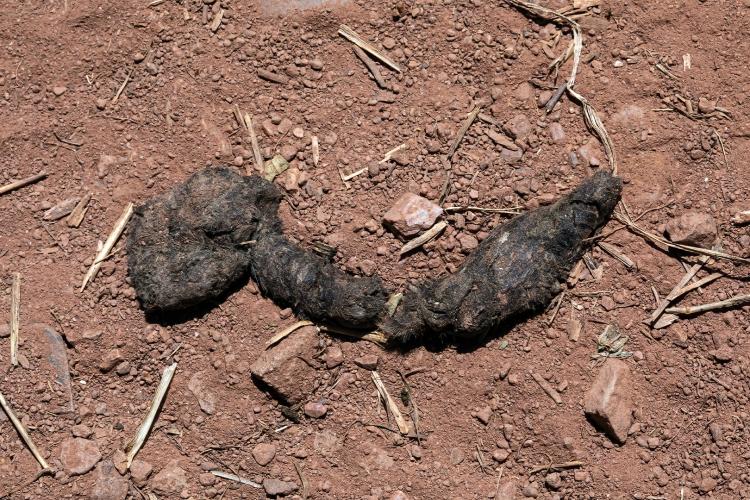Why do coyotes leave poop in conspicuous places?
Like other animals, they are marking their territory, and being subtle about it would not serve their purposes
A photograph of poop or scat arrived in my inbox, and I was relieved to find that it was not an insult. Jeannie Thompson, a CU Boulder alumna, had been out hiking, and when she came across a distinctive scat, she wondered which species had left it. So, she sent it to me for identification.
It looked like a twisted fibrous rope, except that the fibers that wrapped the outside and protruded from the inside were animal hairs. I recognized it immediately—a coyote had been dining on local prey. I had seen something similar in the Maroon Bells Snowmass Wilderness (and I took a picture with good detail for your viewing pleasure.
Coyotes prefer small prey, so the hair visible in the scat in this photo might have been from pika, shrews, deer mice, voles, chipmunks, rabbits, hares or ground squirrels.
As soon as I identified the specimen, the photograph raised another question: Why do coyotes drop scat so frequently on trails? The photo that Jeannie sent and my photo show scat deposited in the middle of a trail. This is a common sight, and it has often occurred to me that if coyotes relieved themselves in random places, coyote scat on a trail would be a rare sight.
But coyotes go out of their way to drop scat on trails, or at the junction of two trails, or on top of a rock to communicate with other coyotes—it is called scent marking.

At the top of the page: A coyote in Rocky Mountain National Park. Photo by Jeff Mitton. Above: Coyote scat looks like twisted hair rope, is deposited in conspicuous places and exudes much information. Photo by Jeff Mitton.
Many species communicate via scent marking. For example, mountain lions drape scat on tall shrubs. Here in the Rocky Mountains, in addition to coyotes and mountain lions, bobcats, foxes, wolves, martens, bears, weasels, otters, mink, wolverines and badgers engage in scent marking to define their territories or provide information on personal status.
Urine is used for scent marking more commonly than scat and specific glands produce scents as well. Anal, subcaudal and musk glands excrete oily fluids that animals smear on trees to mark their territories or to identify the marker. Dominant males advertise their presence this way, and female coyotes scent mark most frequently when in heat, or estrus. Female coyotes are in estrus only two to five days per year, so it is vitally important that the local males are aware of the opportunity.
Joseph Allen, Marc Bekoff and Robert Crabtree conducted a study of coyote scent marking that provided much insight. They observed five packs living in territories in the same valley in Yellowstone National Park. Territories are used for hunting, mating and rearing young, and members of the resident pack strive to keep others out.
The researchers found that most of the scent marking, usually with urine, was placed at the territorial boundary. Some territorial boundaries were adjacent or shared, so these were marked by both packs. Scent marking was not observed outside territorial boundaries and was concentrated at places where coyotes from other packs intruded. A different study concluded that scat was most commonly placed near the core of the territory—the portion that was defended most aggressively.
Coyotes are not demure and wolves are not sheepish about the placement of scat, urine or the exudates from scent glands. A territory is critical for these animals, and they need others to be warned of the boundaries. Scat is deposited and urine is sprayed where it will be most apparent.
Coyotes, wolves and bears have scent glands on the pads of their feet and between their toes. This is part of the reason that mountain lions, coyotes and wolves scrape the ground and place the dirt in a mound near scat. In dogs, these glands leave a scent that reveals gender and might also create a trail that can be followed. If dogs can do it, I am sure coyotes and wolves can as well.
Coyotes, wolves and bears have scent glands on the pads of their feet and between their toes. This is part of the reason that mountain lions, coyotes and wolves scrape the ground and place the dirt in a mound near scat.
For those of us whose sense of smell is minimal, claims about information provided in scent marks may trigger skepticism. But dogs can dispel that skepticism. When dogs are trained to identify a particular scent, they can reliably find drugs or explosives in luggage, and they can identify people with cancer, diabetes or infectious diseases such as Covid.
Genetic differences among species explain differences in olfaction, or the ability to smell different fragrances. Humans have 390 active genes for olfactory recognition, but dogs have at least 800, and coyotes and wolves have even more.
A comparison of olfactory ability of dogs, coyotes and wolves was conducted by scanning the cribriform plate in skulls. Olfactory nerves on the roof of the nasal cavity pass through this plate on their way to the brain. In the process of domestication from wolves, dogs lost olfactory receptors. The study suggested that coyotes and wolves have even greater capacity than dogs for detecting and discriminating odors.
It is fascinating to imagine the sensory world of dogs and their ancestors. Scat and urine reveal the species that deposited the scent, their gender, dominance and aspects of physical condition. Scents reveal invisible trails, warn of predators and lead to prey in the dark. Their eyesight is sharp, but I wonder whether they gather more information by sniffing than looking.
Did you enjoy this article? Subscribe to our newsletter. Passionate about ecology and evolutionary biology? Show your support.

